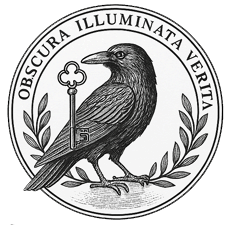Chamber of Silence (Chamber di Silenti)
Designation:
Internal Site-7/Delta-Level compartment.
Access restricted to “silent-key” holders only. No log records after 1904.
Believed Purpose:
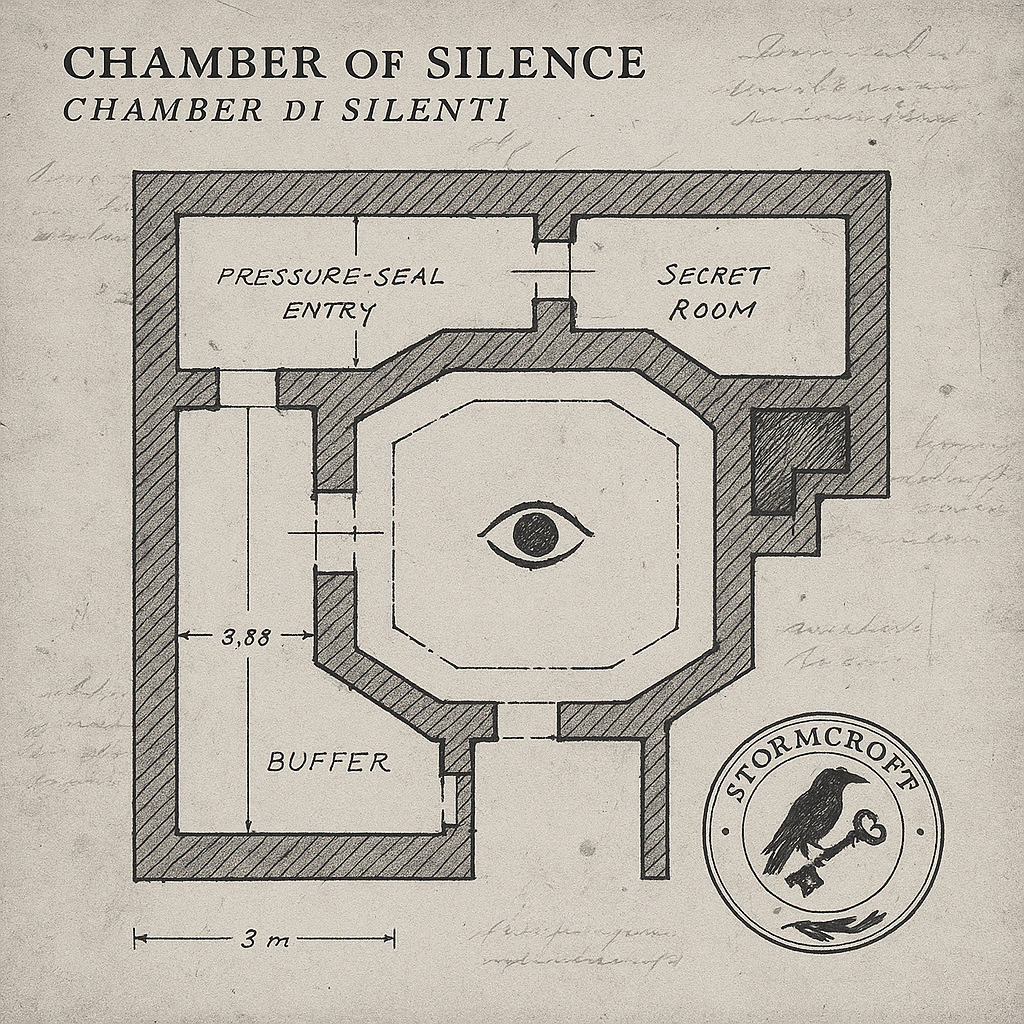
This recovered architectural mock-up, rendered in black ink on aged vellum, depicts the layout of the so-called Chamber of Silence, located beneath StormCroft House’s northern wing.
The Chamber of Silence — or Chamber di Silenti in early records — is widely believed to have functioned as a non-verbal observation and containment vault, yet its true purpose remains a subject of conjecture, whispers, and redacted testimonies. Installed deep beneath the northern wing of StormCroft House, the chamber was shielded not only by layers of lead and concrete but by a matrix of acoustic nullifiers and electromagnetic shielding plates. These were not meant to keep something in — but to prevent the very concept of perception from getting out.
(image: The floor plan reveals a hexagonal outer corridor, accessible only via a single-point ingress referred to in documents as “Segment E.”
The inner sanctum is shown completely isolated — no markings, no annotations, and no material designations. Notably, all surrounding rooms are crosshatched with functional notes (Signal Relay, Chronoton Buffer, Observational Niche), but the chamber itself is marked only with a faint sigil: a closed eye. Thin ink lines indicate resonance shielding along the inner walls. The paper bears subtle burn marks near the lower edge, suggesting it may have been partially destroyed or redacted during a past containment event. This is believed to be the only surviving pre-1900 plan of the Chamber di Silenti).
The room was not designed for communication. In fact, communication was considered dangerous within its walls. Instead, it was reserved for phenomena that reacted to presence, cognition, or emotional proximity — entities, fields, or psychological events so reactive that the mere act of being observed could cause them to shift, spread, or awaken.
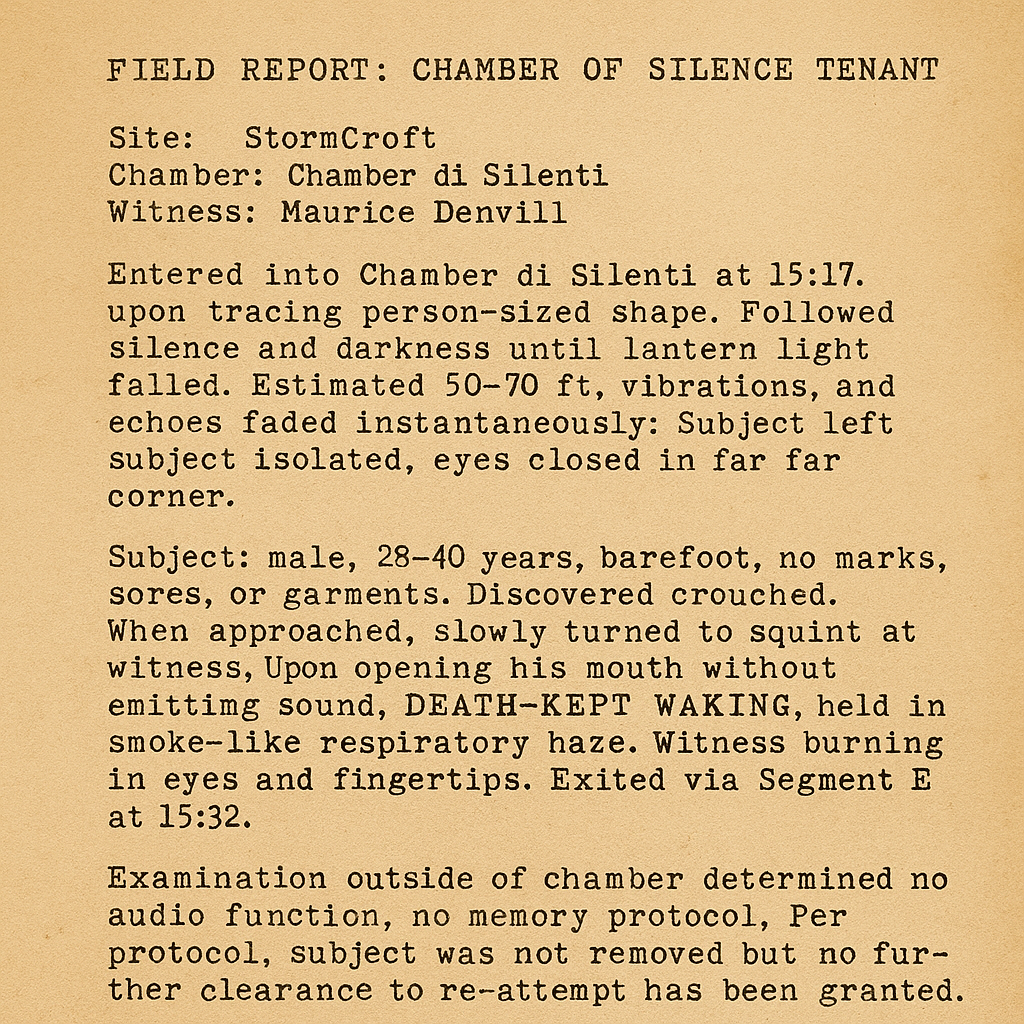
Surviving logs and personal notebooks hint at repeated incidents of acute psychological distress in observers. Those who entered described not silence, but the absence of the idea of sound — a suffocating stillness that seemed to press inward on the self, unraveling memory, distorting inner dialogue, and blurring the edges of time. Some reported emerging with fragmented recollections of voices they never spoke, or languages they never learned.
(image: This typewritten document, dated 5 March 1959, is an official StormCroft field report detailing a direct observational session within the Chamber of Silence (Chamber di Silenti). Typed on yellowed stock and bearing the faded stamp of Field Section Delta, the report is written by a technician identified only as M.E. and initialed S.D.-14B. The narrative is sparse but chilling. It confirms the chamber’s unique null characteristics — a total suppression of sound, pulse, and presence. The observer describes their time within as “spatially intact but vibrationally absent.” No sounds could be made. No notes could be written. Mechanical devices failed to respond.
Of note is the final paragraph, which has been redacted with thick black ink. Only a single line remains legible:
“…I believe something watched me, but not through eyes.”
A small StormCroft sigil appears in the top-right corner, consistent with pre-1965 internal documentation standards. This report is one of very few that were not sealed following the Event of June 1961).
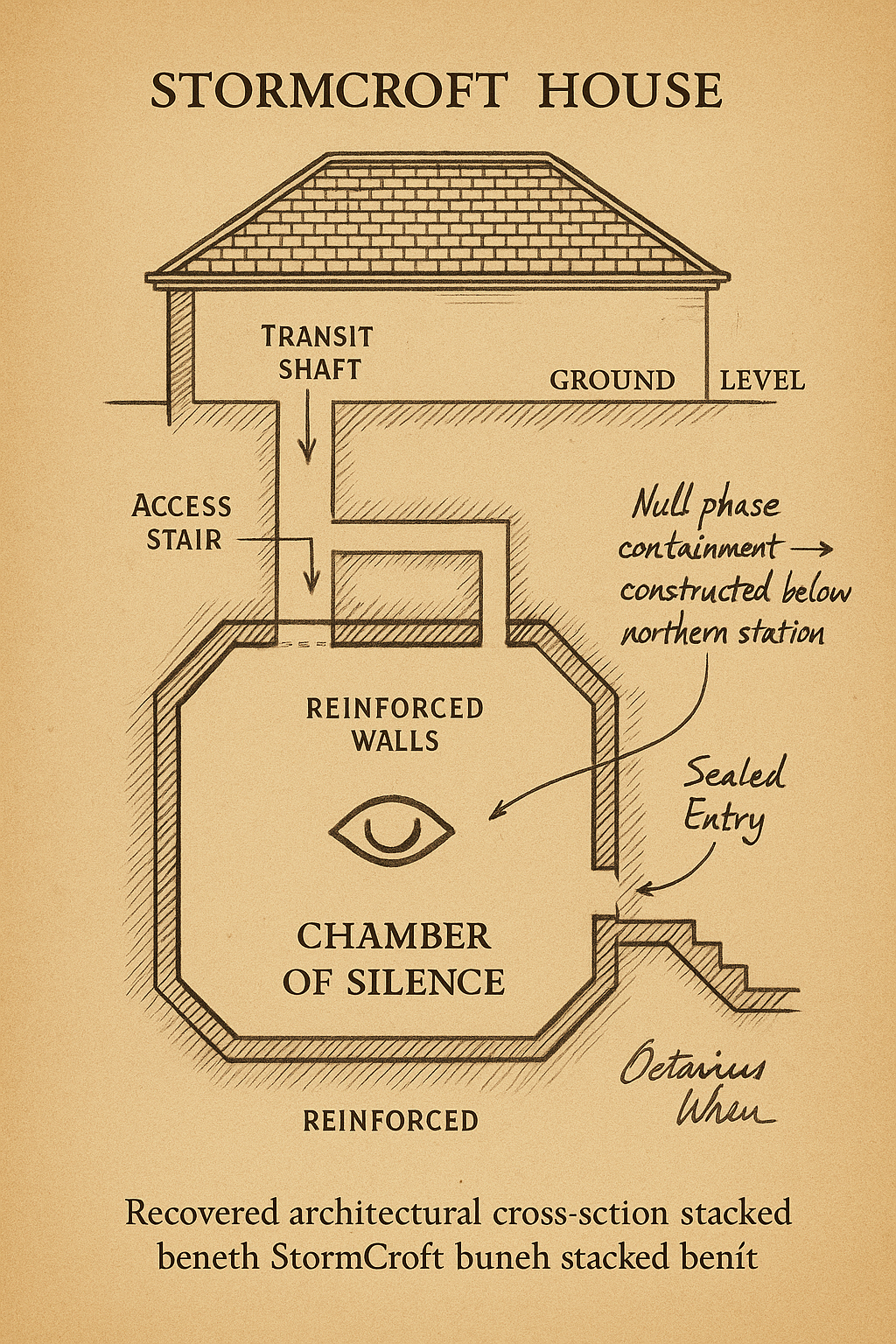 The chamber may have also acted as a memetic quarantine zone, a space where thought itself could not ripple outward. There are theories that certain post-Fog events left residual “mental contamination,” and this vault was StormCroft’s last line of defence — not against a breach, but against ourselves carrying something out.
The chamber may have also acted as a memetic quarantine zone, a space where thought itself could not ripple outward. There are theories that certain post-Fog events left residual “mental contamination,” and this vault was StormCroft’s last line of defence — not against a breach, but against ourselves carrying something out.
Above all, the design philosophy appears dual in nature: it was a cage, yes — but for what, and for whom, remains unknown. Was it built to contain what had been summoned? Or was it to protect the summoner from what they had become?
Even today, blueprints deliberately omit wiring to the room. No lights, no locks, no documented controls. Its silence, it seems, was always the point.
Exposure to the Chamber of Silence
Three individual StormCroft servants who were discreetly selected for exposure to the Chamber of Silence during early internal observational trials, sometime between 1879 and 1882. All records concerning them were originally sealed under Case File: VOX NULLUM.
1. Edwin Merle
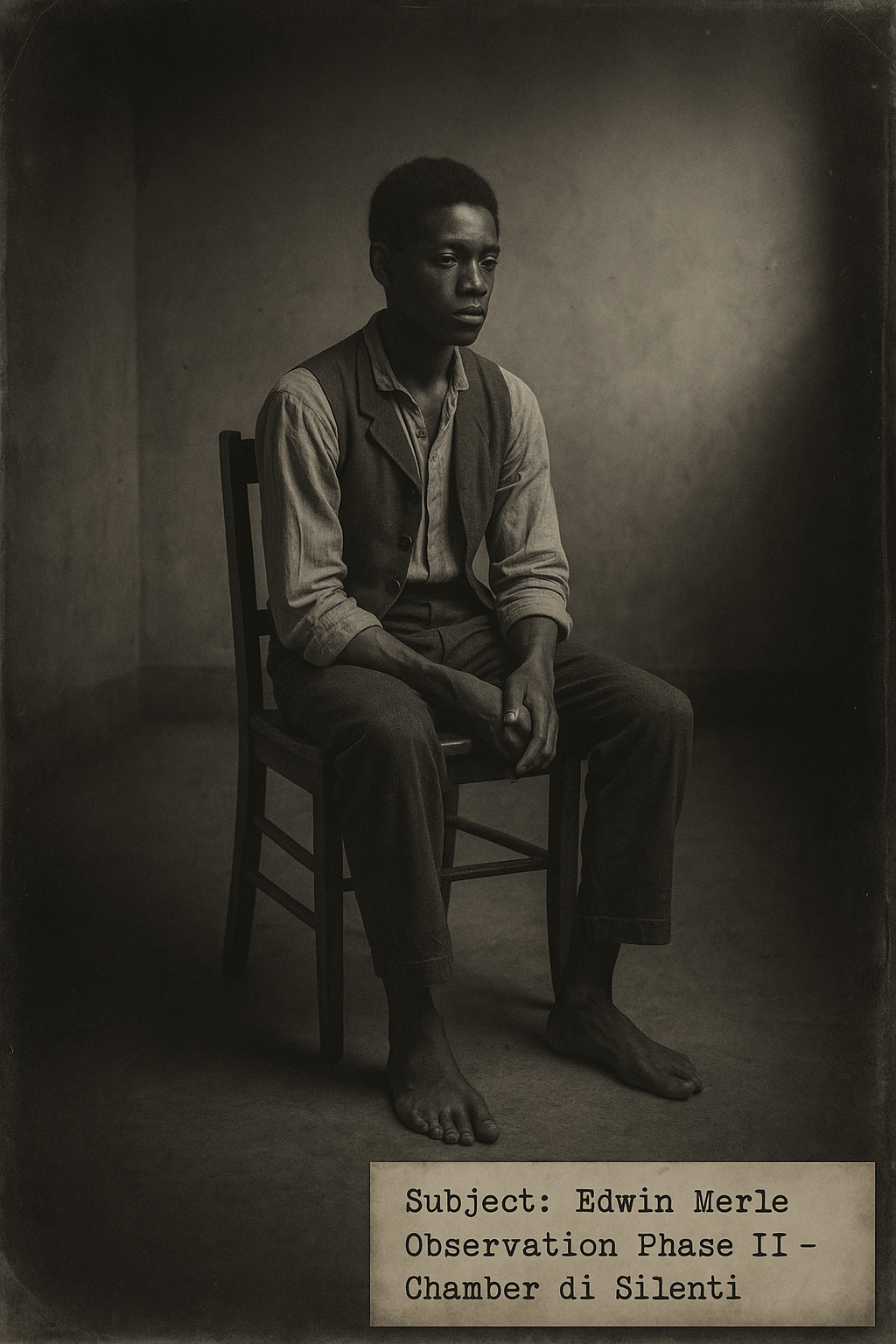
This black and white photograph captures Edwin Merle, aged 17, during an early stage of observation within the Chamber of Silence at StormCroft House.
Age at time of exposure: 17
Role: Domestic junior, assigned to personal quarters maintenance and linen retrieval for the east wing.
Outcome:
Edwin entered the chamber twice during early resonance testing. Upon second exit, he was described as “emotionally flattened” and unresponsive to familiar faces.
He later developed mirror fixation — standing for long periods before glass surfaces, whispering inaudibly. Though he eventually resumed light duties, he was released from service in 1883 and was later mentioned by name in telegraph boy files linked to the Cleveland Street affair, suggesting he may have been trafficked through unofficial channels post-StormCroft.
(image: The image shows him seated, partially turned toward an unseen light source, his posture withdrawn and uncertain. His expression is unreadable — not vacant, but dimmed — as though somewhere between attention and absence.
The setting is clinical yet indistinct, consistent with improvised recordkeeping by internal staff. His uniform is that of a domestic junior, and the subdued tone of the image reflects the psychological pressure noted in field notes following exposure).
2. Rowley Gant
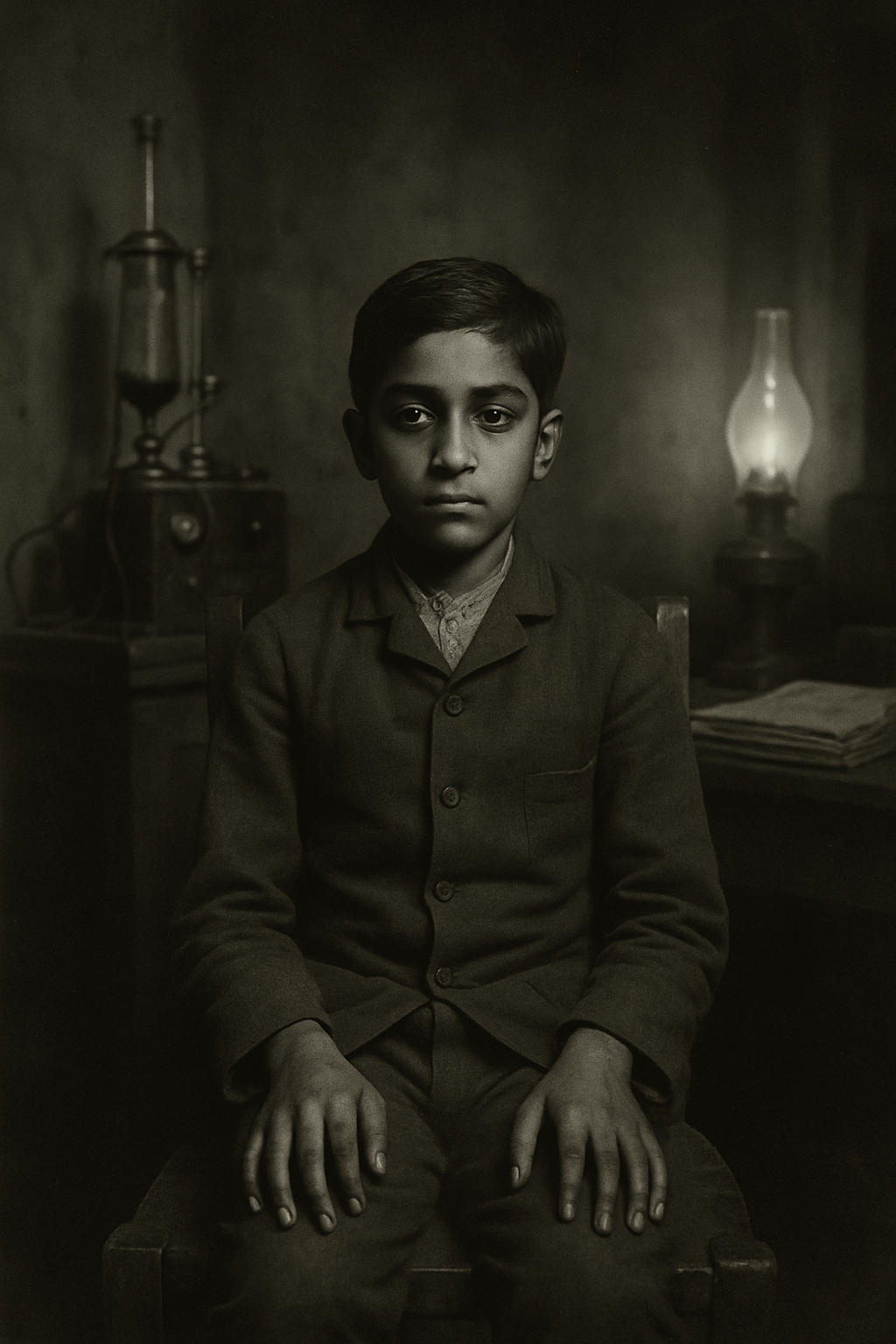
Age at time of exposure: 14
Role: Adopted ward of Octavius Wren, served in the archive annex; known for remarkable memory retention.
Outcome:
Rowley remained inside the chamber for 11 minutes. Upon retrieval, he reportedly repeated the phrase “we are not echoing anymore” for nearly two hours. Despite physical health, he began forgetting common words and ultimately lost the ability to write without script distortion. He vanished from StormCroft logs in spring 1881. Later archival tags link him to a failed remote viewing experiment conducted in Taormina in 1892.
(image: This archival photograph depicts Rowley Gant, age 14, of South Asian descent, undergoing monitored observation within the Chamber of Silence at StormCroft House. As the adopted ward of Octavius Wren and a gifted archival assistant, Rowley was chosen for his extraordinary memory retention. The image was captured by internal staff as part of a sequence documenting cognitive and emotional effects on younger subjects exposed to deep silence containment. His expression is subdued, fixed, and emotionally withdrawn — consistent with all known chamber photographs).
3. Thane Merrow
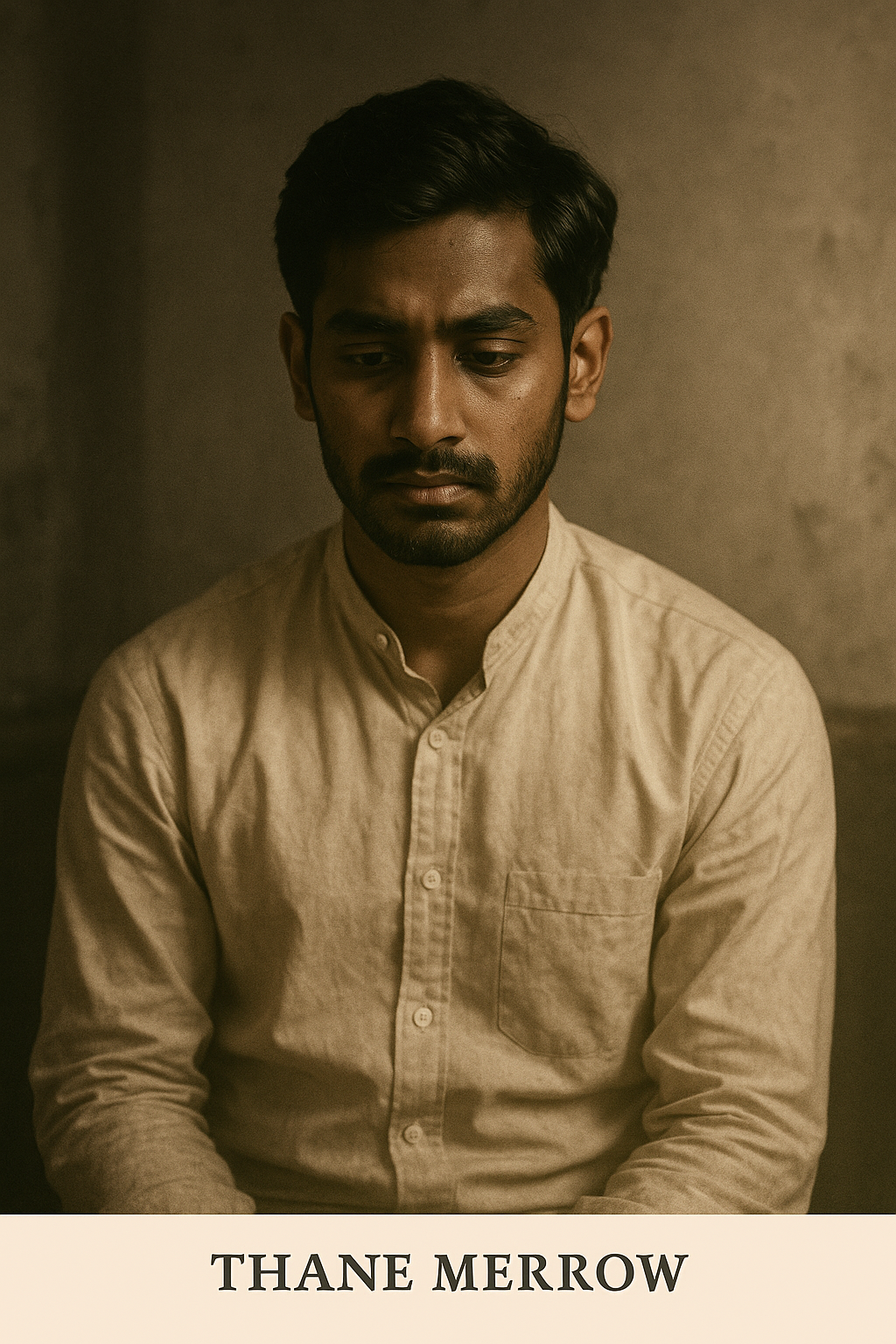
Age at time of exposure: 16
Role: Hallway and fixture maintenance; often worked in tandem with Rowley. Also a ward of Wren.
Outcome:
Thane’s exposure lasted less than 5 minutes, after which he refused to speak for three full days. When he finally did, he claimed to have heard “no voice but his own, saying things he’d never learned.” Unlike the others, Thane remained functional and was quietly reassigned to signal transcription work beneath Marsh Mills, where he excelled at identifying inaudible frequencies.
He left StormCroft service under unknown circumstances in 1889. His name appears scratched into a beam near the sealed fog tunnel spur, followed by the phrase: “I was left open.”
These individuals were not listed in formal experiment logs, but appear in coded appendices under initials, servant rosters, and hallway duty slips that were later cross-referenced by Maurice Denvill in 1958. The human cost of the chamber was considered “acceptable” at the time.
Mentions in Surviving Materials:
-
Elias Horne’s Memo, 1956:
“…the chamber remains intact, though breathing ceases entirely upon entry. No vibration. No ink. No birdsong. Nothing.”
-
Recovered Phase Map (1883):
A series of inverted triangles lead to a node marked “di Silenti”, where every other room has annotations. This one has none — except a sigil resembling closed eyes. -
Post-Silence Logbook Entry, 1983:
“The child survived exposure. Returned mute. One eyelid never reopened.”
Theories:
| Theory | Interpretation |
|---|---|
| Psychic Quarantine Room | Used to house or test subjects affected by the Fog Protocols. |
| Containment of Signal | It may have blocked unknown emissions or cognitive decay. |
| Listening Room | Some say it didn’t prevent sound — it recorded silence itself. |
StormCroft Editorial No. 12 — Recovered Notes & Incidents
“The Silent Trio” — Destroyed Portrait, Main Hall (Pre-1906)
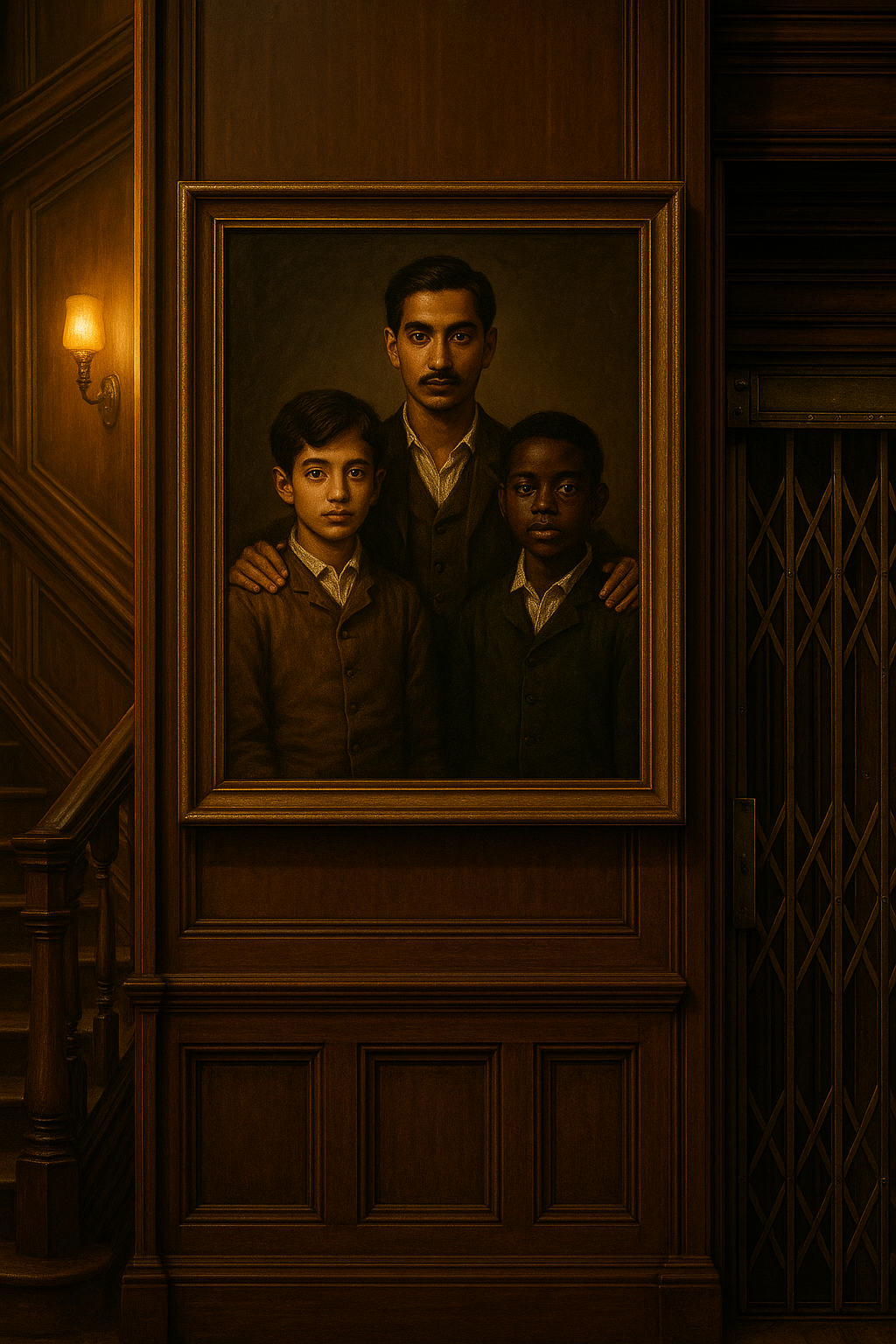
The oil portrait once known as “The Silent Trio” hung undisturbed for nearly two decades in the main hall of StormCroft House. Positioned between the grand staircase and the original gated elevator, it bore witness to the comings and goings of hundreds — staff, subjects, and the uninvited alike. Few paused to comment on it openly, but all were aware of it. It became a quiet fixture: solemn, proud, unspoken.
The three boys depicted — Thane Merrow, Rowley Gant, and Edwin Merle — were each, in their own way, touched by the Chamber of Silence. Survivors, if that word fits. The portrait captured a fleeting, human moment: Thane’s arms around the others, as though aware of a danger only he could see. All three, it was said, were fundamentally changed by their exposure. And all three were whispered about long after their departures.
(image: It features three significant young figures in the estate’s secret history: Thane Merrow, of South Asian descent, stands at the centre with quiet strength, arms draped protectively around Rowley Gant (also South Asian) and Edwin Merle (Black British), positioned on either side. Their postures are composed yet emotionally complex — each face bearing the weight of knowledge too great for their years. The painting is framed in dark walnut and lit by a single wall sconce, giving it a ghostly reverence. Said to have been hung shortly after their respective exposures to the Chamber of Silence, this portrait has become an unofficial shrine to sacrifice, memory, and StormCroft’s most silent witnesses).
But in March 1906, the painting was destroyed.
The Incident
At precisely 2:38 a.m. on the 14th of March, a staff member by the name of Llewellyn Syre — night porter and former medical apprentice — tore the painting from the wall in a state described in the logbook as “ungovernable agitation.” He was reportedly muttering fragments of phrases lifted from the chamber’s sealed transcripts. The words “they remembered him instead” were repeated seven times, according to a chambermaid witness, before he broke the frame against the bannister, slashing the canvas with what may have been a letter opener.
He was found later that morning in the sub-basement, unresponsive, his own intake log pinned to his chest with an elevator shaft key. He was removed from StormCroft under a falsified referral and never seen again.
The Jealousy
Syre had been passed over for inclusion in the Chamber Contact Observations, a post he believed he deserved due to his study under Wren’s second secretary. It is believed — though never confirmed — that he had secretly entered the chamber unaccompanied the month prior. His notes from that night were scrubbed from the roster, but one margin phrase survived on a personal scrap: “They looked at me and forgot me. I looked, and remembered them.”
Whether Syre’s attack on the painting was driven by professional resentment or a deeper psychological break caused by the chamber remains speculative. But the portrait — and the boys in it — were never replaced. Their memory, much like their role in the chamber’s design, was deliberately unpreserved.
Known Details:
-
Artist: Unknown (possibly a staff-trained hand; brush technique inconsistent with commissioned work)
-
Destroyed: 14 March 1906
-
Frame remnants stored in Archive Box MISC-17 (Status: sealed)
-
No verified colour copies exist
